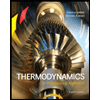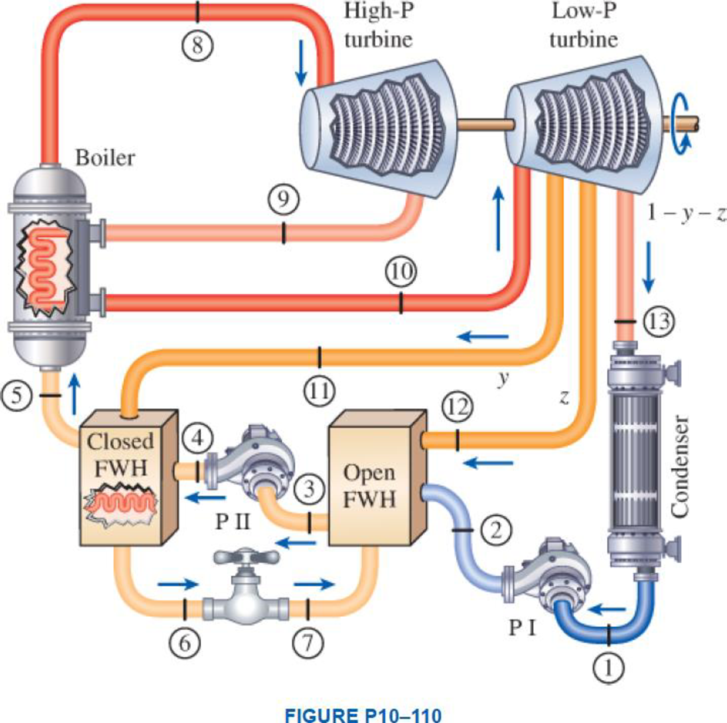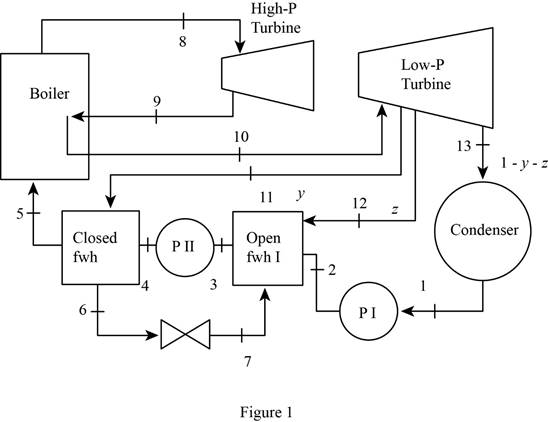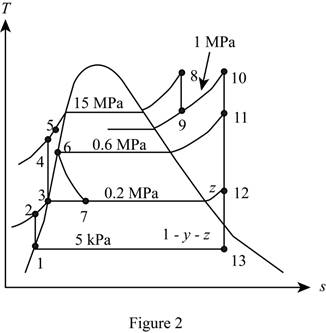
A steam power plant operates on an ideal reheat–regenerative Rankine cycle with one reheater and two feedwater heaters, one open and one closed. Steam enters the high-pressure turbine at 15 MPa and 600°C and the low-pressure turbine at 1 MPa and 500°C. The condenser pressure is 5 kPa. Steam is extracted from the turbine at 0.6 MPa for the closed feedwater heater and at 0.2 MPa for the open feedwater heater. In the closed feedwater heater, the feedwater is heated to the condensation temperature of the extracted steam. The extracted steam leaves the closed feedwater heater as a saturated liquid, which is subsequently throttled to the open feedwater heater. Show the cycle on a T-s diagram with respect to saturation lines. Determine (a) the fraction of steam extracted from the turbine for the open feedwater heater, (b) the thermal efficiency of the cycle, and (c) the net power output for a mass flow rate of 42 kg/s through the boiler.

(a)
The fraction of steam extracted from the turbine for the open feed water heater.
Answer to Problem 110RP
The fraction of steam extracted from the turbine for the open feed water heater is
Explanation of Solution
Draw the schematic layout of the given power plant that operates on an ideal reheat-regenerative Rankine cycle as shown in Figure 1.

Draw the
Figure 2.

Here, water (steam) is the working fluid of the ideal regenerative Rankine cycle. The cycle involves two pumps.
Write the formula for work done by the pump during process 1-2.
Here, the specific volume is
Write the formula for enthalpy
Write the formula for work done by the pump during process 3-4.
Here, the specific volume is
Write the formula for enthalpy
Write the formula for enthalpy
The quality of water at state 13 is expressed as follows.
The enthalpy at state 13 is expressed as follows.
Here, the enthalpy is
Write the general equation of energy balance equation.
Here, the rate of net energy inlet is
At steady state the rate of change of net energy of the system
Refer Equation (VIII).
Write the energy balance equation for open feed water heater.
Here, the mass fraction steam extracted from the turbine to the inlet mass of the boiler
Rewrite the Equation (IX) in terms of mass fraction
For the open FWH,
Here, the mass fraction steam extracted from the turbine to the inlet mass of the boiler
Solving Equation (XI).
Conclusion:
At state 1:
The water exits the condenser as a saturated liquid at the pressure of
Refer Table A-5, “Saturated water-Pressure table”.
The enthalpy
Substitute
Substitute
From the Table A-5, “Saturated water-temperature Table” obtains the value of the enthalpy
Substitute
Substitute
From the Table A-5, “Saturated water-temperature Table” obtains the value of the enthalpy
Here, the temperature at the state 6
Substitute
From the Table A-6, “Superheated water” obtains the value of the enthalpy
From the Table A-6, “Superheated water” obtains the value of the enthalpy
Here, the entropy at the state 9
From the Table A-6, “Superheated water” obtains the value of the enthalpy
Refer Table A-6, “superheated water”, and write the enthalpy at state 11 at pressure of
Here, enthalpy of saturation liquid at pressure of
Write the formula of interpolation method of two variables.
Here, the variables denote by x and y is specific entropy and specific enthalpy at state 11 respectively.
Show the specific enthalpy at state 11 corresponding to temperature as in Table (1).
|
Specific entropy at state 11 |
Specific enthalpy at state 11 |
| 7.7097 | 3270.8 |
| 7.7642 | |
| 8.0041 | 3483.4 |
Substitute
Substitute
Similarly repeat the Equation (XIV) for specific enthalpy at state 11 corresponding to the pressure of
From the Table A-5, “Saturated water” obtains the value of the specific entropy of saturated liquid
Substitute
Substitute
Substitute
Substitute
Thus, the fraction of steam extracted from the turbine for the open feed water heater is
(b)
The thermal efficiency of the cycle.
Answer to Problem 110RP
The thermal efficiency of the cycle is
Explanation of Solution
Write the formula for heat in
Write the formula for net power output of the cycle per unit mass.
Write the formula for thermal efficiency of the cycle
Conclusion:
Substitute
Substitute 0.06215 for
Substitute
Substitute
Thus, the thermal efficiency of the cycle is
(c)
The net power output for mass flow rate of
Answer to Problem 110RP
The net power output for mass flow rate of
Explanation of Solution
Write the expression for net power output for mass flow rate of
Here, the mass flow rate through the boiler is
Conclusion:
Substitute
Thus, the net power output for mass flow rate of
Want to see more full solutions like this?
Chapter 10 Solutions
Thermodynamics: An Engineering Approach
Additional Engineering Textbook Solutions
Shigley's Mechanical Engineering Design (McGraw-Hill Series in Mechanical Engineering)
Introduction To Finite Element Analysis And Design
DeGarmo's Materials and Processes in Manufacturing
Mechanics of Materials
Manufacturing Engineering & Technology
Fluid Mechanics: Fundamentals and Applications
- Consider a steam power plant that operates on the ideal reheat Rankine cycle. The plant maintains the boiler at 5400 kPa, the reheat section 1100 kPa, and the condenser at 10 kPa. The mixture quality at the exit of both turbines is 94 %. Determine the following values. (1) The specific enthalpy at the exit of the high-pressure turbine. (2) The specific entropy at the exit of the high-pressure turbine. (3) The temperature at the inlet of the high-pressure turbine. (4) The temperature at the inlet of the low-pressure turbine. (5) The thermal efficiency of the cycle.arrow_forwardThermodynamics 2 Consider a steam power plant that operates on a reheat Rankine cycle and has a net power output of 91 MW. Steam enters the high-pressure turbine at 10 MPa and 500 C and the low-pressure turbine at 1 MPa and 500 C. Steam leaves the condenser as a saturated liquid at a pressure of 10 kPa. The isentropic efficiency of the turbine is 95 percent, and that of the pump is 90 percent. The required power input in the pump in MW.arrow_forwardA steam power plant operates on an ideal regenerative Rankine cycle with two open feedwater heaters. Steam enters the turbine at 10 MPa and 600C and exhaust to the condenser at 5 kPa. Steam is extracted from the turbine at 0.6 and 0.2 MPa. Water leaves both feedwater heaters as a saturated liquid. The mass flow rate of steam through the boiler is 22 kg/sec. Show the cycle on a T-s diagram, and determine (a) Total power requirement of the pump in Hp, (b) Turbine power output in MW, (c) the net power output of the power plant in MW, (d) mass of steam extracted for feedwater heating in kg/sec,arrow_forward
- Consider a steam power plant that operates on a reheat Rankine cycle and has a net power output of 80 MW. Steam enters the high-pressure turbine at 10 MPa and 500°C and the low-pressure turbine at 1 MPa and 500°C. Steam leaves the condenser as a saturated liquid at a pressure of 10 kPa. The isentropic efficiency of the turbine is 80%, and that of the pump is 95 %. Show the cycle on a T-s diagram with respect to saturation lines, and determine (a)the quality (or temperature, if superheated) of the steam at the turbine exit, (b)the thermal efficiency of the cycle, and (c)the mass flow rate of the steam.arrow_forward2. A steam power plant operates on the Rankine cycle in which the steam enters the turbine at 16 MPa and 600°C and the condensate leaves the condenser at 10 kPa. If the isentropic efficiency of the turbine is 87 percent and the isentropic efficiency of the pump is 85 percent, determine (a) the thermal efficiency of the cycle and (b) the net power output of the plant for a mass flow rate of 15 kg/s.arrow_forwardA steam power plant operates on an ideal reheat Rankine cycle between the pressure limits of 14 MPa and 10 kPa. The mass flow rate of steam through the cycle is 10 kg/s. Steam enters both stages of the turbine at 500°C. If the moisture content of the steam at the exit of the low-pressure turbine is not to exceed 12 percent, determine (a) the pressure at which reheating takes place, (b) the total rate of heat input in the boiler, and (c) the thermal efficiency of the cycle. Also, show the cycle on a T-s diagram with respect to saturation lines.arrow_forward
- A steam power plant operates on an ideal regenerative Rankine cycle with two open feedwater heaters. Steam enters the turbine at 8 MPa and 550C and exhausts to the condenser at 10 kPa. Steam is extracted from the turbine at 0.6 and 0.2 MPa. Water leaves both feedwater heaters as a saturated liquid. The mass flow rate of steam through the boiler is 16 kg/s. Show the cycle on a T-s diagram, and determine (a) the net power output of the power plant and (b) the thermal efficiency of the cycle.arrow_forwardA steam power plant operating on the intermediate steam Rankine cycle produces a net power of 160 MW. Water vapor enters the turbine at a pressure of 15 MPa and a temperature of 600 oC, and the condenser at a pressure of 15 kPa. The isentropic efficiency of the turbine is 85 percent and the isentropic efficiency of the pumps is 90 percent. In order to heat the feed water, some steam is separated from the turbine at a pressure of 0.6 MPa and sent to the open feedwater heater and exits the heater as a saturated liquid. Accordingly, fill in the blanks below. (Pump 1 inlet will be considered as saturated liquid.) a) The mass flow rate of the steam passing through the boiler is m5= ..... kg/s. b) The mass flow rate of the steam separated from the turbine to heat the feed water is m6= ...... kg/s. c) The heat entering the cycle is Qin = ...... kW. d) The heat released from the cycle is Qout = ...... kW. e) The power produced in the turbine is WTurbine= ...... kW. f) The power consumed in…arrow_forward1. What is the Isentropic Work of the Steam using the Ideal Rankine Cycle when the system is set at 400 kPaa Boiler Pressure and 105 kPaa Condenser Pressure when the system is generating power at 9,500 seconds? 2. With the Turbine work output, what is the Isentropic efficiency of the Turbine from the above settings?arrow_forward
- A simple ideal Rankine cycle which uses water as the working fluid operates its condenser at 40C and its boiler at 300C. Calculate the work produced by the turbine, the heat supplied in the boiler, and the thermal efficiency of this cycle when the steam enters the turbine without any superheating.arrow_forwardConsider a steam power plant that operates on the ideal regenerative Rankine cycle with a closed feedwater heater. The plant maintains the turbine inlet at 3000 kPa and 350 deg C; and operates the condenser at 10 kPa. Steam is extracted at 1000 kPa to serve the closed feedwater heater, which discharges into the condenser after being throttled to condenser pressure. The temperature of the feedwater entering the boiler is 210 deg C. a.)Calculate the work produced by the turbine in kJ/kg. b.)Calculate the work consumed by the pump in kJ/kg. c.)Calculate the heat supply in the boiler for this cycle per unit of boiler flow rate in kJ/kg. d.)Calculate the cycle thermal efficiency in %.arrow_forwardWater is the working fluid in a regenerative Rankine cycle with one closed feedwater heater and one open feedwater heater. Steam enters the turbine at 1400 lbf/in.2 and 1150°F and expands to 500 lbf/in.2, where some of the steam is extracted and diverted to the closed feedwater heater. Condensate exiting the closed feedwater heater as saturated liquid at 500 lbf/in.2 undergoes a throttling process to 120 lbf/in.2 as it passes through a trap into the open feedwater heater.The feedwater leaves the closed feedwater heater at 1400 lbf/in.2 and a temperature equal to the saturation temperature at 500 lbf/in.2 The remaining steam expands through the second-stage turbine to 120 lbf/in.2, where some of the steam is extracted and diverted to the open feedwater heater operating at 120 lbf/in.2 Saturated liquid exits the open feedwater heater at 120 lbf/in.2The remaining steam expands through the third-stage turbine to the condenser pressure of 5 lbf/in.2 The turbine stages and the pumps each…arrow_forward
 Elements Of ElectromagneticsMechanical EngineeringISBN:9780190698614Author:Sadiku, Matthew N. O.Publisher:Oxford University Press
Elements Of ElectromagneticsMechanical EngineeringISBN:9780190698614Author:Sadiku, Matthew N. O.Publisher:Oxford University Press Mechanics of Materials (10th Edition)Mechanical EngineeringISBN:9780134319650Author:Russell C. HibbelerPublisher:PEARSON
Mechanics of Materials (10th Edition)Mechanical EngineeringISBN:9780134319650Author:Russell C. HibbelerPublisher:PEARSON Thermodynamics: An Engineering ApproachMechanical EngineeringISBN:9781259822674Author:Yunus A. Cengel Dr., Michael A. BolesPublisher:McGraw-Hill Education
Thermodynamics: An Engineering ApproachMechanical EngineeringISBN:9781259822674Author:Yunus A. Cengel Dr., Michael A. BolesPublisher:McGraw-Hill Education Control Systems EngineeringMechanical EngineeringISBN:9781118170519Author:Norman S. NisePublisher:WILEY
Control Systems EngineeringMechanical EngineeringISBN:9781118170519Author:Norman S. NisePublisher:WILEY Mechanics of Materials (MindTap Course List)Mechanical EngineeringISBN:9781337093347Author:Barry J. Goodno, James M. GerePublisher:Cengage Learning
Mechanics of Materials (MindTap Course List)Mechanical EngineeringISBN:9781337093347Author:Barry J. Goodno, James M. GerePublisher:Cengage Learning Engineering Mechanics: StaticsMechanical EngineeringISBN:9781118807330Author:James L. Meriam, L. G. Kraige, J. N. BoltonPublisher:WILEY
Engineering Mechanics: StaticsMechanical EngineeringISBN:9781118807330Author:James L. Meriam, L. G. Kraige, J. N. BoltonPublisher:WILEY





